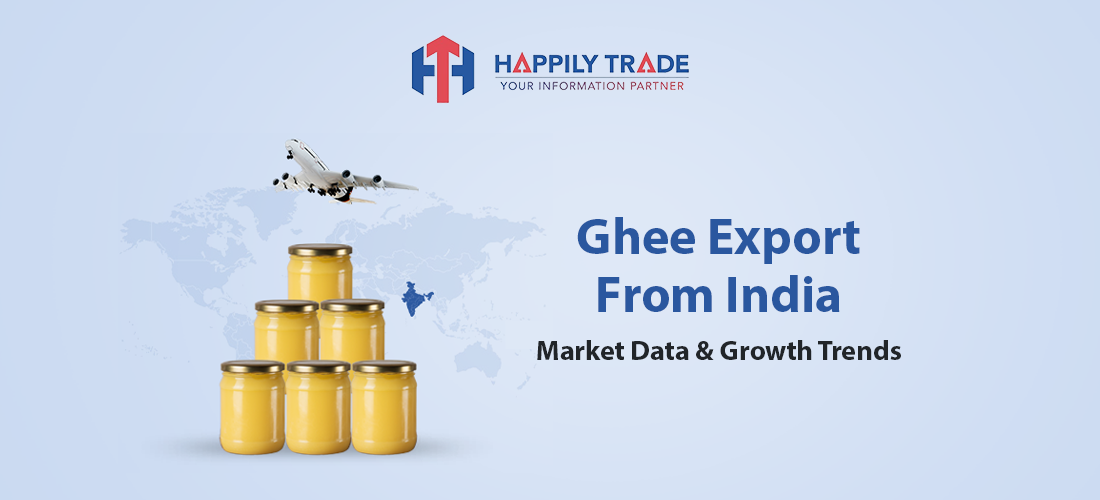Ghee Export from India: Unlocking Global Markets
- Log in to post comments
Ghee Export from India is witnessing an unprecedented surge, driven by rising global demand and the country's deep-rooted dairy traditions. Recent figures indicate that India exported approximately 37,000 metric tons of ghee during the 2022-23 fiscal year, marking it as the nation's top dairy export. Among this, "desi ghee" accounted for nearly 18,000 metric tons. Between March 2023 and February 2024, India recorded 9,206 ghee export shipments, reflecting a 15% increase from the previous year. This growth was supported by 874 exporters, highlighting the expanding footprint of Indian ghee in international markets.
With the rise of health-conscious consumers worldwide, ghee has gained recognition as a superfood, further boosting export opportunities. Businesses can leverage ghee export data to tap into global markets and drive profitability.
India's Dominance in the Global Ghee Market
India is the world’s largest producer and consumer of ghee, with a dairy industry valued at over $160 billion. The country’s traditional ghee-making methods, using cow and buffalo milk, have gained international acclaim. The top export destinations for ghee from India include:
- United Arab Emirates (UAE) - One of the largest importers, owing to the high Indian diaspora and demand for traditional dairy products.
- United States - Increasing interest in Ayurvedic diets and healthy fats has increased Indian ghee imports.
- Australia and Canada - A growing preference for organic and clarified butter options has expanded market opportunities.
- Bangladesh and Nepal - Neighboring countries rely on Indian dairy exports due to cultural and economic ties.
Factors Driving the Growth of Ghee Exporters in India
1. Health Benefits and Superfood Recognition
Ghee is rich in Omega-3 fatty acids and vitamins A, D, E, and K and has numerous health benefits, including improved digestion, anti-inflammatory properties, and enhanced immunity. As global consumers shift toward natural and organic products, ghee has become preferred, especially among followers of the keto and paleo diets.
2. Increasing Demand in the Food Industry
Ghee is widely used in confectionery, bakery, and processed foods. Major international food brands incorporate ghee into their product lines, further driving demand. India's ghee exports have significantly benefited from this trend.
3. Rising Indian Diaspora and Cultural Influence
With over 32 million Indians living abroad, traditional Indian foods, including ghee, have seen exponential demand. Indian restaurants, grocery stores, and supermarkets worldwide stock high-quality ghee to cater to this demographic.
4. Government Initiatives and Export Incentives
The Indian government has promoted dairy exports through policies like the National Programme for Dairy Development (NPDD) and export subsidies. These initiatives support businesses by streamlining export procedures and ensuring quality compliance.
Challenges in Ghee Export from India
Despite its promising growth, Indian ghee exporters face several challenges:
1. Stringent Quality Regulations
Different countries have varying standards for dairy imports, including microbiological limits, fat content requirements, and labeling regulations. Meeting these criteria is crucial for market penetration.
2. Fluctuating Dairy Prices
Milk prices in India fluctuate due to seasonal production changes and feed costs. This impacts the cost of ghee production, affecting export pricing and competitiveness.
3. Logistics and Cold Chain Management
Since ghee is a dairy product, maintaining quality during transportation is essential. Efficient cold chain logistics and packaging ensure product integrity in export markets.
4. Competition from Other Countries
India faces competition from countries like New Zealand, the Netherlands, and the United States, which also export clarified butter and dairy products. Strengthening brand identity and leveraging traditional ghee-making techniques can help Indian exporters stand out.
Market Trends and Future Outlook
1. Organic and Grass-Fed Ghee Demand
The organic, grass-fed ghee market is expanding, particularly in the U.S., Canada, and Europe. Consumers are willing to pay premium prices for high-quality, ethically sourced ghee.
2. E-commerce and Direct-to-Consumer (DTC) Sales
The rise of online platforms has enabled Indian exporters to reach global consumers directly. Marketplaces like Amazon, Flipkart, and specialized dairy e-commerce platforms have increased accessibility and boosted sales.
3. Expanding Middle Eastern and African Markets
Countries in the Middle East and Africa have shown rising demand for ghee, driven by traditional cooking practices and a growing preference for Indian dairy products.
4. Technological Advancements in Dairy Processing
Advanced processing techniques ensure longer shelf life and enhanced product quality, making Indian ghee more competitive internationally.
Leveraging Ghee Export Data for Success
Accessing and analyzing ghee export data is crucial for businesses looking to succeed in this dynamic market. Ghee export data provides valuable insights into the following:
- Market Trends: Analyzing ghee export data reveals trends in global demand, allowing exporters to identify promising markets and adjust their strategies accordingly.
- Pricing Dynamics: Understanding pricing trends helps exporters to price their products competitively and maximize profitability.
- Competitive Landscape: Ghee export data provides insights into competitors' activities, enabling exporters to benchmark their performance and identify areas for improvement.
- Buyer Information: Accessing buyer information through import export data companies can help exporters connect with potential customers and build strong business relationships.
Conclusion
India's ghee exports are on an upward trajectory, driven by growing health awareness, international demand, and robust government support. With exports reaching $170 million in 2023 and continuing to rise, the Indian dairy industry stands to gain significantly from global expansion.
For businesses looking to enter or scale in the ghee export market, leveraging ghee export data and partnering with an import export data company can provide strategic insights and a competitive edge. By addressing logistical challenges, ensuring quality compliance, and tapping into emerging markets, Indian ghee exporters can unlock immense opportunities worldwide.
Frequently Asked Questions
1. What are the requirements to export ghee from India?
You need an FSSAI license, APEDA registration, IEC code, and compliance with importing country standards.
2. Which countries import Indian ghee?
Major importers of Indian ghee include the USA, UAE, Australia, Canada, Singapore, and Saudi Arabia.
3. What certifications are needed for ghee exports?
Ghee exports require FSSAI, AGMARK, APEDA, HACCP, and ISO certifications.
4. How can I find buyers for ghee exports?
Find buyers through B2B platforms (Happily Trade Exim), trade fairs, export councils (APEDA), and direct marketing.
5. What is the best shipping method for exporting ghee?
Use air freight for small, high-value shipments and sea freight for bulk exports.








